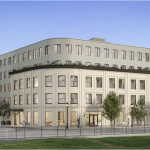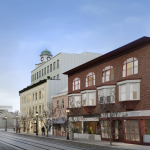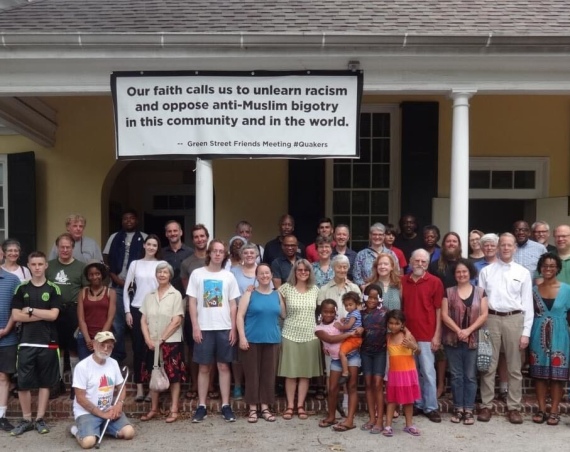The five-story building proposal set for development on Germantown Avenue, right next to the historical Germantown Town Hall building, has been motioned to continue its design review process by the Civic Design Review Committee (CDRC) during a meeting on Tuesday, September 3, afternoon.
Before finalizing a design, this will add yet another step for developers, Canno Design, Iron State Real Estate, and Colliers Engineering and Design, since receiving their zoning permit in April. The extensive process of finding a final design stems from their communication with the CDRC, Philadelphia City Planning Commission (PCPC), and Germantown community organizers, who have presented them with many suggestions to better accommodate the busy, historic avenue.
The 75-unit plan for 5932-42 Germantown Avenue consists of 44 one-bedroom apartments, 21 two-bedroom apartments, ten studio apartments, a 38-spot parking garage, two commercial spaces, and a bike storage area on the ground floor.
With plans to stand between Haines and Harvey Streets with its front facing Germantown Avenue, the 96,645 square foot property will be developed on a site that was previously a daycare center. The current one-story structure will be demolished to make way for the project.
Gabrielle Cannon, Principal Architect from Canno Design, Devon Beverly, the project’s attorney, and Andrew Eisenstein, the developer from Iron State Real Estate, were in attendance to represent the project. Cannon gave an overview of the development and detailed some of its changes that derived from public comments and committee member suggestions from past meetings.
The current design shows that there will be a setback after the first three stories that will push the top two stories back 10 feet. This move is an attempt to better complement Germantown Avenue, which has many three-story buildings that face the main street.
“The building did get set back off of the neighboring northern property line an additional three feet after having meetings with the neighborhoods and [hearing] their requests to set it back,” Canno said. “We reduced one of the two-bedrooms into a one-bedroom, which has enabled us to [adjust to] houses that front Harvey Street; we moved the building off of their back property lines.”
Canno also emphasized how the materials of the apartment building’s exterior were implemented for a similar, complimentary purpose.
“The material palette was inspired by the Town Hall building; our goal was to complement it,” Canno said. “The first three stories are large window openings with brick detailing and a beige brick color.
After the setback, there will be box ribbed corrugated metal that will have a greenish hue that’s similar to the top of the town hall. There will also be round corners in the front of the building, which were also implemented to complement the historic neighboring building with a round effect.
There’s an alleyway with a 12-foot wide road in between Town Hall and the proposed property, which will serve as the driveway that will accompany the residential entrance and the parking garage entrance. The entrances into the commercial spaces will face Germantown Avenue.
The proposal also presents a shared roof deck, a green roof, street trees and plants surrounding the property, balconies for northern units, and an outdoor common area.
Trash disposal will also be on the ground floor, and trash pick-up will be utilized on the property’s driveway.
According to WHYY, Eisenstein stated that construction is expected to start next spring and will take two years to compete.
Eliza Bowers, Urban Designer from the Philadelphia City Planning Commission (PCPC), then discussed a list of staff comments for the developers to keep in mind.
Bowers mentioned how PCPC staff would like to see direct entrances for the three ground floor units, A bike rack outside of the building, the drive aisle turned into a curbless driveway to reduce ADA complications, and the brick material extended to all facades of the building since all facades can be viewed from multiple angles.
They would also like to see adjustments in the windows on the east and rear facades to maximize natural light and airflow in the units and a diversified tree canopy species to help the area’s biodiversity.
The staff would like to see more clarification about the flow of sanitation trucks, commercial vehicles, and delivery vehicles that would utilize the driveway to ensure a safe, consistent flow of vehicles. Showing more consistency between rendered plans and written plans is another component of the development process that the PCPC wants to see.
With this development rising amid historical landmarks, public transportation stops, schools, and a passageway of the 14th district police station, community members voiced some of their concerns about the building that would require further review.
Julie Stapleton Carroll, the zoning chair of the West Central Germantown Neighbors (WCGN), discussed some main points that came out of a community meeting on August 21.
“One thing that has not been mentioned that is of concern to the community is the location of the 14th District Police Station, which is directly behind this proposed property and uses that alley-way as their egress both in and out of the police station,” Carroll said.
“It increases our concern in regards to safety, in addition to the general concerns that would come out of a 75-unit building with a 12-foot alley-way, which does not provide opportunities for two cars to pass each other,” Carroll added. “We would like to see a detailed plan in conjunction with the police department.”
“In Germantown, many apartment units are springing up with no affordable housing options, and we would love to see developers include that as part of their development,” Carroll said. “We’re happy to work with them on ways to think about that and brainstorm.”
She concluded by mentioning how the vacant area of the site also has historical significance and requested that any archaeological findings be shared with the community.
“I just think this project is too large; it dwarfs Town Hall. This is on a national historic landmark,” SoLo Germantown Civic Association member Allison Weis said. “There needs to be more respect for the history of Germantown Avenue, and the design just doesn’t seem compatible.”
“I would also like to see more attention to the solar energy that the Planning Commission mentioned and surfaces that will help with heat emission from the parking area; some kind of painted surface that reflects the sunlight,” Weis added. “And more attention towards conserving energy and stormwater management. We could do a whole lot better.”
Charles Richardson, a representative from Councilwoman Cindy Bass’ office, gave a comment on behalf of the Councilwoman.
“Unfortunately, we have a whole lot of buildings that are popping up in that general vicinity that are adding a lot more density to that area,” Richardson said. “As far as the rest of the design and materials, we’re just going to be observant in regards to that, but we just wanted to make sure it is well known that the Councilwoman feels that this is too large of a project for that location.”
During the comment period of the CDRC, the main emphasis was on pedestrian safety and the effectiveness of the driveway, as well as obtaining consistent renderings of all designs to give the committee an accurate look into what to expect.
“There may be some pedestrians wandering down the [alley],” CDRC member Ashley DiCaro said. “Maybe replace the grass strip that is shown on the site plans with an actual sidewalk so [people] will be able to get off the driveway and walk a bit more safely.”
“There’s a lot relying on how that alleyway road functions: relying on it to get rid of refuse and recycling, access to the garage, and there’s units that look out onto it both from the ground floor and upstairs,” said CDRC member Daniel Garofalo. “Unless this drive functions cleanly, without hazard, without hardships for the adjacent properties, this project doesn’t work.”
“This is a case where you’re really going to have to work with all agencies that have jurisdiction [and] all neighbors of the community,” Garofalo added. “It's a thoughtful and sophisticated design, the units are realistic and could even accommodate small families, so there’s a lot of thoughtful elements to this, but the biggest challenge and what needs to be solved is the access.”
In the committee voting period, the motion to conclude the Civic Design Review process did not pass. The motion to continue the review process passed with a four to three committee vote, so there will be another CDRC review scheduled for the project in the future.
Some of the information in this article about the CDRC meeting was sourced from the Philly Documenters program, which trains and pays people to take notes at public meetings. You can see and hear more from this meeting here.





